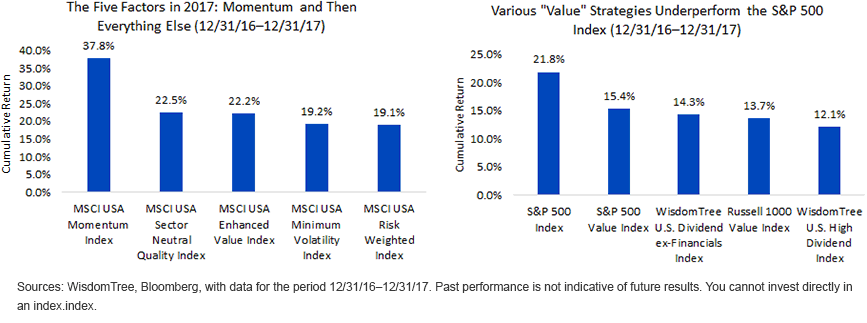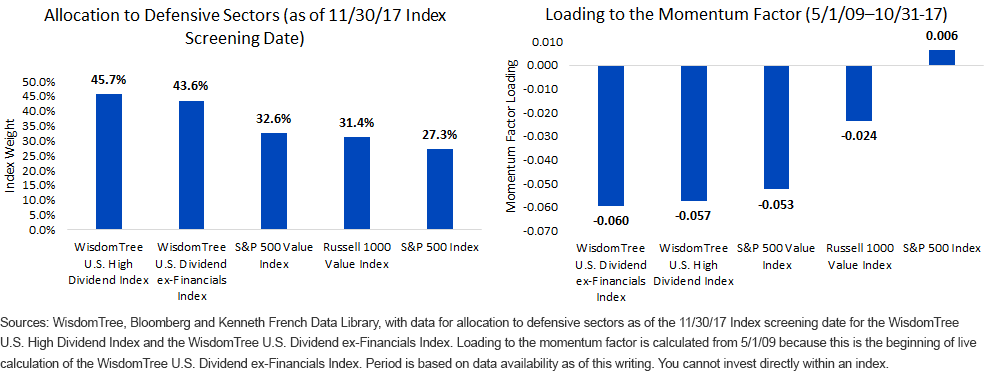Will Defensive, Anti-Momentum Strategies Rise Up in 2018?


One of the more interesting things that happened in asset management in 2017 regarded factors. While the concept of factors associated with risk-adjusted outperformance has existed for decades, in 2017 investors saw the ability to allocate either to individual factors or to multifactor strategies enter the mainstream in a big way. Investors will likely continue to evaluate different factors in order to gain unique insights into where the equity market may go next.
2017: Momentum and Then Everything Else
If we array MSCI’s five USA factor indexes—what many view as the baseline starting point of factor discussions—we see that in 2017 the MSCI USA Momentum Index returned nearly 38%.1 The next-best index—the MSCI USA Sector Neutral Quality Index—returned only 22.5%.2 This is a massive gap. In fact, the four factor indexes outside of momentum were all within a range of less than 4% of one another.
Value: In a Way, the Opposite of Momentum
Sometimes it is worth exploring strategies that aren’t really among the “worst” performers but are also far from the best. The WisdomTree U.S. High Dividend Index and the WisdomTree U.S. Dividend ex-Financials Index are two such strategies. While these were up 12.1% and 14.3%, respectively, in a year where the S&P 500 Index was up 21.8%, clearly there was little reason to draw much attention in this direction.3
However, it is notable that these strategies are right in line with the S&P 500 Value Index and Russell 1000 Value Index benchmarks. In a way, these strategies could be thought of as the opposite of momentum and growth—the avenues that generated some of the best outperformance in 2017.
“Value” Doesn’t Mean the Same Thing for All Indexes
Some might ask, why did the MSCI USA Enhanced Value Index outperform both the S&P 500 Value Index and the Russell 1000 Value Index in 2017? The answer: the MSCI USA Enhanced Value Index is tilted back toward being sector neutral to the MSCI USA Index,4 which will tend to mitigate the risk of, say, being very under-weight in the Information Technology sector during a year (like 2017) in which it delivered very strong performance. A typical value strategy would not make this adjustment.
In our view, focusing on the opposite of what delivered the strongest performance in 2017 could be a different way to think about 2018.
Dare to Think Differently and Diverge from Momentum in 2018

WisdomTree’s Annual Rebalance Redefines the “Value” Paradigm with a Dividend-Yield Focus
The tie that binds both the WisdomTree U.S. High Dividend Index and the WisdomTree U.S. Dividend ex-Financials Index together is a focus on higher-yielding dividend payers.
- On an annual basis, the WisdomTree U.S. High Dividend Index screens and sorts across all regular dividend payers and locates the top 30% on the basis of dividend yield for inclusion. Weighting is then by WisdomTree’s measure of the Dividend Stream® (dividend per share x number of shares outstanding).
- Also on an annual basis, the WisdomTree U.S. Dividend ex-Financials Index screens and sorts across all large-cap regular dividend payers outside of the Financials sector and locates the top 10 stocks by dividend yield in each sector. Weighting is then by dividend yield, making the Index look very similar to an equally weighted approach.
Since stocks with higher yields tend to have a better chance at inclusion within these Indexes and falling prices are one way to gain higher yields, there has tended to be an anti-momentum bias to these exposures. At each rebalance, these methodologies can pick up stocks with rising dividend yields and falling price levels.
Focus on Dividend Yield also Has Led to Defensive Equity Exposure
Now, we recognize that some years are like 2017, where volatility is very low and the more defensive exposure you have (Consumer Staples, Health Care, Telecommunication Services and Utilities sectors), the worse you tend to do on a relative basis against a benchmark like the S&P 500 Index, since higher-growth, more cyclical sectors went on a run.
But, although companies such as Facebook, Amazon, Netflix and Google (FANG stocks) are changing the way people are living their daily lives, the growth/momentum/cyclical part of the U.S. equity market cannot lead indefinitely. The WisdomTree U.S. High Dividend Index and the WisdomTree U.S. Dividend ex-Financials Index are ways to get a completely different exposure to U.S. equities. This different way of doing it was not rewarded in 2017, but for those thinking that the U.S. equity rally could be getting long in the tooth, these strategies may add more value in 2018.
Quantifying the Defensive Sector, Anti-Momentum Tilts

1Source: Bloomberg, from 12/31/16 to 12/31/17.
2Source: Bloomberg, from 12/31/16 to 12/31/17.
3Source: Bloomberg, from 12/31/16 to 12/31/17.
4Source: “MSCI Enhanced Value Indexes Methodology,” MSCI, 5/15.
Important Risks Related to this Article
Dividends are not guaranteed, and a company currently paying dividends may cease paying dividends at any time.

Christopher Gannatti began at WisdomTree as a Research Analyst in December 2010, working directly with Jeremy Schwartz, CFA®, Director of Research. In January of 2014, he was promoted to Associate Director of Research where he was responsible to lead different groups of analysts and strategists within the broader Research team at WisdomTree. In February of 2018, Christopher was promoted to Head of Research, Europe, where he was based out of WisdomTree’s London office and was responsible for the full WisdomTree research effort within the European market, as well as supporting the UCITs platform globally. In November 2021, Christopher was promoted to Global Head of Research, now responsible for numerous communications on investment strategy globally, particularly in the thematic equity space. Christopher came to WisdomTree from Lord Abbett, where he worked for four and a half years as a Regional Consultant. He received his MBA in Quantitative Finance, Accounting, and Economics from NYU’s Stern School of Business in 2010, and he received his bachelor’s degree from Colgate University in Economics in 2006. Christopher is a holder of the Chartered Financial Analyst Designation.

